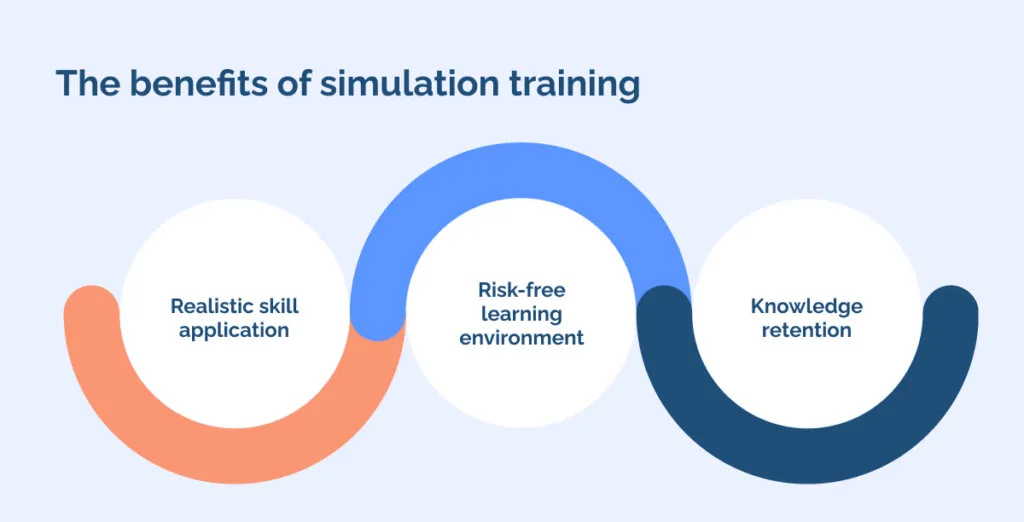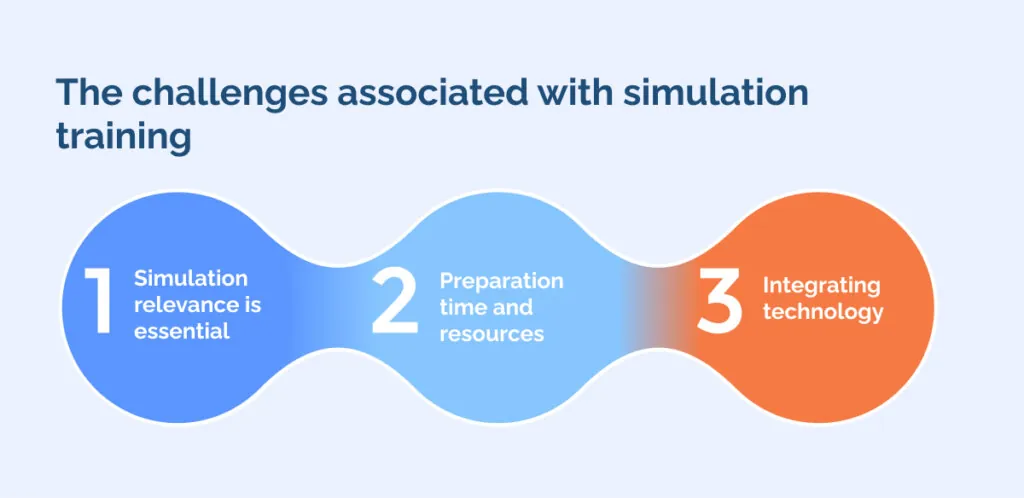
For high-risk tasks, difficult communications, and complex situations, simulation training is an effective learning technique for staff at all levels.
In the past few decades, software and hardware have increased the range of simulation formats. But at its most basic, anyone can introduce elements of simulation into their training programs, through role play and serious games.
This article will show how this employee training method fits into organizational learning and development. We will:
- Define the concept of simulation training;
- Examine several key examples of simulation training in action;
- Look at the benefits and challenges of implementing simulation-based learning.
This type of training method is a huge research area. But by the end of this article, you’ll be able to see how it could work for your business.
What is simulation training?
Simulation training replicates real-world scenarios in a controlled environment, allowing individuals to experience and interact with lifelike situations. This training approach aims to develop skills, knowledge, and decision-making abilities by providing a safe and immersive space for practical application and experiential learning.
Exercises using simulation are most useful for training employees in challenging, high-risk, and costly scenarios. It can be delivered in a variety of ways: software, role-play, case study review – or a combination of all of these.
When it comes to implementing simulation-based training in business contexts, we can find a strong track record of useful applications. Simulations are an effective application at all levels of the hierarchy, from new and junior staff, up to senior leadership. However, the most critical developments in simulation training have come from high-risk practical industries, such as healthcare, defense, and aviation.
What are the different types of simulation training?

There are many forms of simulation training. It can be high-tech, homemade, generic, highly specific, and everything in between. This section will introduce some of the key formats for simulation training: in situ, VR, tabletop, role-playing, and serious games. Training leaders can pursue any of these options, or they may wish to combine methods to enhance their training project outcomes.
As we explain these different formats, we will see that most of these types of training are not specific to any one industry. Indeed, most types of simulation training are relevant for any business that involves high-pressure and unpredictable situations. Whether that’s risk management, banking, or software development, simulation training has something to offer.
And within each industry, simulation training can benefit staff at all levels of experience and hierarchy. For entry-level positions and higher education training, it’ll be about building confidence and developing reflective capacities. Whereas people in leadership positions will expand their skill set to a more challenging set of problems.
Below, we outline the following different types of training:
- VR-based simulation training
- Tabletop simulation training
- Role-playing simulation training
- Serious games
- In-situ simulation training
VR-based simulation training
VR simulation training involves the use of Virtual Reality (VR) technology to create immersive, computer-generated environments for training and educational purposes.
Participants wear VR headsets or head-mounted displays (HMDs) that transport them to realistic, three-dimensional scenarios. In these virtual environments, participants can interact with objects, simulate tasks, and make decisions as if they were in the actual physical setting.
How to implement VR simulation training
VR simulation training can be costly – so the implementation process needs to be handled carefully. Assuming that you already know your training needs, think about the following steps:
- Brainstorm how VR training could solve your needs. Why is VR the best technique to use? What kind of hardware and software would bring the scenario to life for your employees?
- Identify a training partner. Most companies will not have the internal capacity to build the right solution. Companies like vive, Immersion, and others, can direct you to the most effective methods.
- Keep it going. Like any new method of training, you will need to continue to work to embed the solution. After an initial setup, VR can be a long-term tool in your training portfolio.
Tips for effective VR simulation training
Although VR simulation is a proven method for the most dangerous industries, it also has many applications for general business skills. As 2021 analysis in HBR highlights, presentation skills, customer service, and employee evaluation can be simulated through VR.
Tabletop simulation training
Tabletop simulation training is a form of simulation that doesn’t involve physical movement or immersive technologies but is instead conducted through discussion and problem-solving around a table.
Participants are often key stakeholders or decision-makers. They engage in a facilitated discussion of a simulated scenario, typically a complex situation or problem relevant to their work environment. This method is commonly used in industries such as emergency management, crisis response, and business continuity planning.
How to implement tabletop simulation training
Tabletop simulations can be a very low-tech training solution. That means that they are highly adaptable, and suitable for the highly specific demands of particular organizations.
When you’re designing a multi-party tabletop exercise, consider using these milestones:
- Bring together your relevant stakeholders for an initial planning meeting. In this meeting, you’ll need to develop the scenario, set objectives, and confirm how much input you’ll need from all the different parties involved. If you get this straight, you’ll be able to streamline many of the later phases.
- At a midterm planning meeting, discuss exercise staffing and determine the exercise invitation process. You’ll need to identify facilitators and evaluators, players and observers from the business units you wish to involve. Around this stage, you will need to delegate responsibility for exercise development: this will require accurate input from everyone concerned.
- At a final meeting, confirm the details of the tabletop exercise. Make sure all administrative tasks are completed.
Tabletop simulations require all the usual logistics associated with an event. Therefore, a long planning process helps to make sure that everything is lined up.
Tips for effective tabletop simulation training
Here are some further tips for tabletop simulations:
- Make sure your administrative processes are effective. Tabletop simulation training is often a one-off event, and it can’t be reproduced to suit every participant. Invitations, confirmations, and venue logistics can make or break a tabletop simulation.
- Develop a clear facilitator handbook. Even if it is a relatively short document, your leaders need to know what they are doing.
- Prepare to share and respond to feedback from many parties. Tabletop games are especially strong as group work exercises.
Role-playing simulation training
A role-playing simulation involves participants taking on specific roles and engaging in simulated scenarios to replicate real-world situations.
This training method is designed to enhance interpersonal skills, communication, and decision-making within a safe and controlled environment. Participants immerse themselves in assigned roles, often representing different stakeholders or characters relevant to the scenario.
Role-playing simulations can take a wide variety of formats – from one-to-one negotiation exercises, up to complex tabletop activities. You could use them in bigger exercises just to give a moment of collaborative learning. But they could form the focus of a training task in themselves.
How to implement a role-playing simulation
Here’s some steps for successfully implementing role-playing simulation:
- At the start of the process, the trainer can take control over every feature of the simulation. They choose an important scenario, identify the roles within it, and provide the most relevant background information about each party.
- Once the trainer has devised their scenarios, they should make preparations to share this information with any relevant stakeholders.
- Before implementing the role play, prepare all learning materials fully. Ensure that participants have the right materials, and are ready to meet the challenges.
Tips for effective role-play simulation training
It can take years of experience to consistently deliver great role-play simulations. If you’re trying to improve your interventions, think about the following ideas:
- Roleplay is most effective when it is closely connected to your employee’s working lives. They will find it much easier to play their parts if they are already familiar with the situation. Keep this in mind when you’re planning and executing a task.
- To build engagement, scheduling your roleplay tasks effectively is also important. If your participants will be tired, hungry, or worried about their work, they may struggle to get into the spirit of the occasion.
- Don’t over-plan your role play. In real life tasks, employees must deal with incomplete and ambiguous information. Role plays are a great way to simulate uncertainty.
Serious games
Serious games are interactive and engaging computer or video games designed with a primary purpose beyond pure entertainment. These games are created to educate, inform, and train staff in real-world scenarios.
How to implement serious games
Here are some steps you should take to implement serious games in your organization:
- Implementing serious games requires the standard routine of preparation – a needs assessment, training, and evaluation.
- However, keep in mind that most serious games are delivered by external partners (like GingrTech) with expertise in gaming and business. Implementing serious games will involve a process of vendor acquisition and management.
- As a result, the best serious game implementations happen over time, through strong relationships between businesses and 3rd party providers.
Tips for training with serious games
When serious games work, they’re great, but it’s important to think about the specific contexts in which they perform well.
- Serious games are especially useful for engagement: helping apathetic staff members to get stuck in and involved, whether individually or in teams.
- However, they aren’t right for every training situation. Serious games are more likely to benefit broad-brush skills training, rather than mastery of particular niche industries.
In-situ simulation training
In-situ simulation training (sometimes abbreviated to InSt) involves conducting simulated exercises or scenarios in the actual working environment, providing a realistic and contextual learning experience. In-situ simulation brings the training directly to the workplace. This approach allows participants to practice and enhance their skills in the same setting where they will apply them in real-life situations.
In-situ simulation training is commonly used in healthcare settings, such as hospitals and emergency departments, but its principles can be applied across various industries where hands-on, contextual learning is crucial for effective skill development and application.
How to implement in situ simulation training
In-situ training has great applications for location-specific high-pressured environments. In customer service, manufacturing, and crisis management, an in-situ exercise can have a very significant impact. It’s been especially important in healthcare situations: and businesses of many kinds can learn from those lessons.
You can implement an “in situ” simulation exercise with these actions.
- Identify a specific situation with a training need. that could involve a poor awareness of facilities, weaknesses in procedure, or misunderstanding about quality assurance.
- Design an “in situ” intervention that answers the training need. It should be planned for a specific time period.
- Communicate the opportunity to staff (mandating sign-ups if appropriate).
- After the simulation runs – reflect, evaluate, and record the outcomes of the intervention.
All of these steps can make sure that you run an effective exercise. .
Tips for effective in situ simulation training
In situ simulations take a lot of careful planning – perhaps more than any of the others we’ve mentioned here.
So it’s important to make sure that the training exercise is linked to a genuine need. If a simpler type of simulation training would be more effective, save “in situ” for another day.
The business applications of simulation training
Simulation training can be a very effective method for many business situations. Here we’ll look at a few of the key applications in which simulation excels.
Project management
Training simulation is useful for the high-stakes business practice of project management.
Even experienced project managers have to adapt to the parameters of new projects, including timescale, budget, outcomes, staffing, and stakeholder priorities. All of these variables will also vary dramatically based on the nature of the project.
Simulation-based training can step in to help in various ways. For a home-grown solution, the planning cycle of tabletop simulation could help every stakeholder represent their needs in a particular scenario. And for more generic training purposes, technology like MIT’s project management flight simulator can provide a ready-made training solution.
Negotiation
Furthermore, simulation training facilitates the development of crucial negotiation skills, such as active listening, effective communication, problem-solving, and adaptability. Role-playing is one of the most effective ways to practice these skills, while balancing all the difficult information.
You can write your own negotiation scenarios for simulation exercises. But remember there are a lot of simulation exercises out there already – such as those held at Harvard’s Teaching Negotiation Resource Center. For trainers who are going deeper, you can investigate research into the role of simulation in negotiation, as Kesting and Smolinski outline in a 2023 article.
Change management
Organizational change projects are very difficult to get right, but different change training can have a hugely positive impact on the overall project.
Simulation training can have a role in change management training in various ways. For example:
- VR simulations help managers prepare for difficult conversations across a heterogeneous site.
- Tabletop simulations can help build the teams to deal with anticipated challenges.
- Serious games help workers at every level of an organization to prepare for the difficulties they will have in the future.
Change projects come with some serious stakes: time, money, and potential down-time all turn them into liabilities.
Decision making
What is the best method of teaching decision-making? Many people would say “making mistakes”. If you don’t have the time or resources to let your staff mess up in real life, simulation training offers a safe alternative. Staff have opportunities to make a decision, get it wrong, and review the impact of their decision – without any negative outcomes for the business.
Decision-making is common to all the different types of simulation training. The specific nature of your decision-making issues will indicate the right course of training materials.
What are the benefits of simulation training?

As we have seen so far, simulation training offers a unique perspective on training needs. From the many benefits of this method, here are three especially distinctive positive features.
Realistic skill application
Simulation training provides a controlled environment where participants can apply their skills in scenarios closely resembling real-world situations. This realistic setting allows individuals to practice decision-making, problem-solving, and other skills without the consequences associated with actual on-the-job errors.
The hands-on experience gained through simulations enhances the transferability of skills to real-life situations.
Risk-free learning environment
Simulation training creates a space where individuals can engage in realistic scenarios without exposing themselves or others to actual risks.
Whether it’s a medical procedure, emergency response, or business decision-making, participants can make mistakes, test hypotheses, and learn from experiences in a controlled setting. This risk-free environment is particularly valuable when dealing with high-stakes or complex situations, allowing learners to build confidence and competence gradually.
Knowledge retention
Simulation training engages participants in hands-on, experiential learning. When individuals actively participate in realistic scenarios, they create vivid and memorable experiences. Experiencing the application of knowledge and skills in a simulated environment forms stronger neural connections in the brain.
This hands-on engagement significantly contributes to the retention of information compared to passive learning methods.
What are the challenges associated with simulation training?

However, simulation-based learning methods aren’t always easy to implement effectively. Here are three reasons why it might be more challenging than you thought.
Simulation relevance is essential
Designing simulations that accurately reflect the complexities, dynamics, and challenges of the actual work environment is crucial for effective training.
The relevance challenge lies in crafting scenarios that resonate with the participants’ daily experiences, align with their roles, and address the specific skills and knowledge they need to acquire. Striking this balance requires a deep understanding of the target audience and their work context.
Inaccurate or overly simplistic simulations may result in disengagement and hinder the transfer of skills to practical situations.
Preparation time and resources
While certain simulation tasks may be straightforward and pre-prepared, larger and more complex scenarios demand extensive resources, in terms of time, effort, and resource input.
Designing intricate simulations that authentically replicate real-world challenges necessitates careful planning, research, and attention to detail. Crafting scenarios that align with specific learning objectives, participant roles, and organizational contexts adds to the complexity. The resource-intensive nature of simulation training experiences can pose a challenge for many organizations.
Integrating technology
As we’ve seen above, technology offers powerful tools for creating immersive and realistic simulations. However, their implementation can be challenging.
Ensuring seamless compatibility, accessibility, and user-friendliness across diverse devices and platforms can be demanding. Additionally, the need for specialized equipment, software, and technical support may pose barriers, particularly for organizations with limited resources.
To overcome technological hurdles, you must not only acquire the necessary tools but also ensure that participants can effectively engage with the tasks.
Simulation training works for all businesses
Simulation training comes in many different forms but with one simple purpose. Simulations can get leaders and staff alike into the narratives and stresses they’ll need to face – but in a safe space in which their decisions have no major impact.
To get the benefits of simulation, you can start by playing games and conducting role-plays. If you ever need a full immersion, VR and in situ methods are available (at a cost).
WalkMe Team
WalkMe spearheaded the Digital Adoption Platform (DAP) for associations to use the maximum capacity of their advanced resources. Utilizing man-made consciousness, AI, and context-oriented direction, WalkMe adds a powerful UI layer to raise the computerized proficiency, everything being equal.



